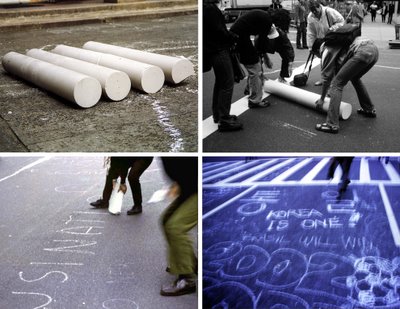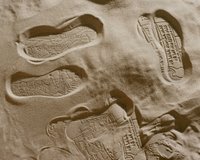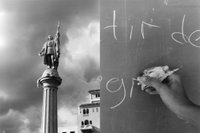 Break the word "question" down to its root--quest--and you get a sense of the insurgent inquiry practiced by artists Jennifer Allora and Guillermo Calzadilla. Their poetic and unabashedly activist conceptual art challenges everything from common definitions--they define protest as "proactive testing" and responsibility as "the ability to respond"--to concepts like free speech and historical commemoration. Confronting the assumptions behind everyday terms arises from a state of permanent questioning, says Calzadilla. "We believe that art has much to offer to this task, in its potential to provoke the public into a space of individual questioning about preconceived notions of truth, about forms of representation, participation, and identification."
Break the word "question" down to its root--quest--and you get a sense of the insurgent inquiry practiced by artists Jennifer Allora and Guillermo Calzadilla. Their poetic and unabashedly activist conceptual art challenges everything from common definitions--they define protest as "proactive testing" and responsibility as "the ability to respond"--to concepts like free speech and historical commemoration. Confronting the assumptions behind everyday terms arises from a state of permanent questioning, says Calzadilla. "We believe that art has much to offer to this task, in its potential to provoke the public into a space of individual questioning about preconceived notions of truth, about forms of representation, participation, and identification."In their Landmark series, created with activists in Vieques, Puerto Rico, they interrogate how land is marked: What traces do we leave of our existence on earth? How is land physically scarred? Who determines which sites are worthy of historic preservation and which--like this tiny, sparsely populated island--aren’t? For more than 60 years, the U.S. military has used Vieques for naval maneuvers, bombing practice, and to test various technologies, including napalm, radioactive depleted uranium shells, and--as was revealed in 2002--germ and chemical warfare agents (secretly tested on the island’s residents in 1969). Allora & Calzadilla, who are based in Puerto Rico, worked with resistance groups to create rubber shoe soles to be worn during civil disobedience actions.
 When activists illegally entered the bombing range--tripping Navy sensors and halting the day’s bombing run (which ultimately became so costly that in 2003 the US government acquiesced and closed the range)--they left behind indented messages created by the resisters. Intended for viewing not by gallery-goers but only by the military staff working the bombing range, the imprints are a way of reclaiming the disputed territory, giving new power to the term "landmark." In a second project, they used satellite images and 3D modeling software to create a two-dimensional depiction of the bomb-pitted topography of Vieques. Presented as geographical contour lines on felt carpeting--a choice that references the term "carpet bombing"--the installation gave visitors to London’s Tate Modern a jarring view of the bombs’ violent reshaping of the terrain.
When activists illegally entered the bombing range--tripping Navy sensors and halting the day’s bombing run (which ultimately became so costly that in 2003 the US government acquiesced and closed the range)--they left behind indented messages created by the resisters. Intended for viewing not by gallery-goers but only by the military staff working the bombing range, the imprints are a way of reclaiming the disputed territory, giving new power to the term "landmark." In a second project, they used satellite images and 3D modeling software to create a two-dimensional depiction of the bomb-pitted topography of Vieques. Presented as geographical contour lines on felt carpeting--a choice that references the term "carpet bombing"--the installation gave visitors to London’s Tate Modern a jarring view of the bombs’ violent reshaping of the terrain.Another work takes on the seeming impermeability of another type of landmark--memorial statues--and the one-sided histories they perpetuate. Inspired by Old San Juan’s most prominent public statues, mercenary explorer Christopher Columbus and conquistador Ponce de Leon, they cast these famous men in an unexpected way--in the impermanent medium of chalk and shrunken to an unmonumental scale. But this inversion wasn’t enough: they then distributed the chalk to area teachers who, in the course of telling stories of conquest and colonization and raising questions about public commemoration of historical events (from whose vantage point is history told?), began the process of dissolving mythologies away into fine dust.
 In nearly all of Allora & Calzadilla’s work, the art object is merely a catalyst, awaiting activation by those who happen upon it. The public art piece Chalk, presented in Lima, Peru in 2002, underscores how a work that was met with relatively benign response during its previous showings has explosive potential in a new context. The artists positioned 24 enormous pieces of chalk in a public plaza adjacent the parliament building and the president’s mansion. Measuring nearly six feet, the cumbersome chalk required passersby to either cooperate in scrawling a message on the ground or break off smaller pieces. As street protesters entered the plaza, chalk smiley faces and doodles gave way to fiercer statements alleging government corruption and unfair labor practices. After three hours, officials shut down the project, breaking up the chalk and hauling it away in a truck, before sending in a cleaning crew to wash the streets clean. Showing "the limits of free speech in a so-called democratic society," in Calzadilla’s words, the project will have another showing--ironically enough--at the Democratic National Convention in Boston, July 26 through 29. In this highly charged setting--a supposedly democratic event where fenced-off "free speech zones" will be situated far out of sight of convention attendees--the defiant questioning that animates all of Allora and Calzadilla’s work shouldn’t be hard to find.
In nearly all of Allora & Calzadilla’s work, the art object is merely a catalyst, awaiting activation by those who happen upon it. The public art piece Chalk, presented in Lima, Peru in 2002, underscores how a work that was met with relatively benign response during its previous showings has explosive potential in a new context. The artists positioned 24 enormous pieces of chalk in a public plaza adjacent the parliament building and the president’s mansion. Measuring nearly six feet, the cumbersome chalk required passersby to either cooperate in scrawling a message on the ground or break off smaller pieces. As street protesters entered the plaza, chalk smiley faces and doodles gave way to fiercer statements alleging government corruption and unfair labor practices. After three hours, officials shut down the project, breaking up the chalk and hauling it away in a truck, before sending in a cleaning crew to wash the streets clean. Showing "the limits of free speech in a so-called democratic society," in Calzadilla’s words, the project will have another showing--ironically enough--at the Democratic National Convention in Boston, July 26 through 29. In this highly charged setting--a supposedly democratic event where fenced-off "free speech zones" will be situated far out of sight of convention attendees--the defiant questioning that animates all of Allora and Calzadilla’s work shouldn’t be hard to find.For more on Allora and Calzadilla, read my interview "The Art of Response-ability."